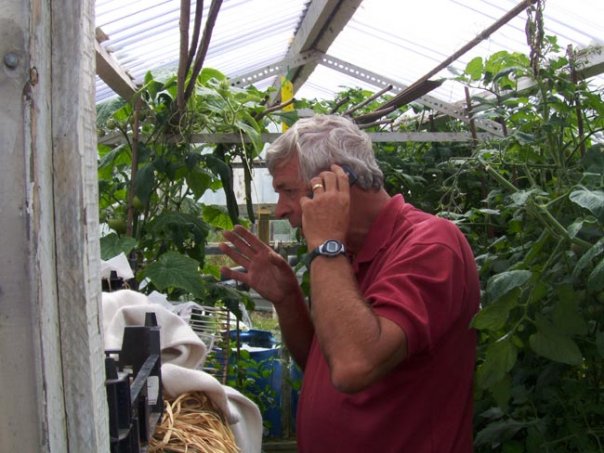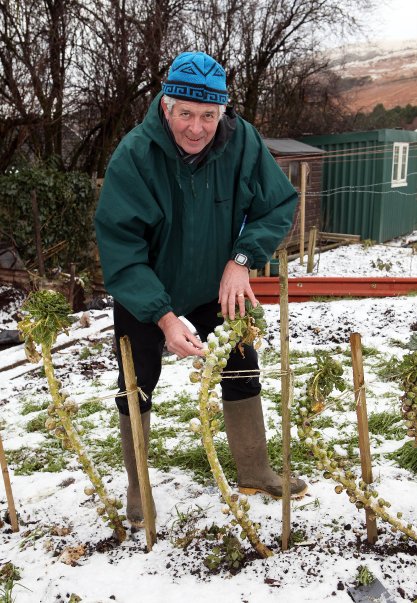Terry Walton – The Life of a Media Allotmenteer
Terry Walton made his long delayed visit to Cothi Gardeners for our November meeting. He was certainly worth the wait and gave us a highly entertaining and informative talk.

The first part of the talk was about how, after retiring from his career as MD of a precision engineering company, he came to be a media allotmenteer appearing on various radio and television programmes. Currently he is a regular Friday afternoon feature on Radio 2’s Jeremy Vine Show and on Radio Wales. Both shows are live broadcasts; for the former he manages to perform his various tasks, often one handed, while communicating via mobile phone with the studio.


He started gardening on an allotment as a child of 4, building up the number of plots he managed to 11 and growing vegetables which he put into veg boxes and then sold to local householders. It being illegal to sell produce from an allotment, he only charged for the box itself and not the veg it contained. By the time he was 17 he was able to buy his first car. He continued to garden his allotment throughout his career, as a hobby.
Terry gardens organically. His allotment is about the size of centre court at Wimbledon, water is collected from a nearby mountain stream and he has an unheated greenhouse on site. He uses a 4 crop rotation which reduces pest problems and maintains fertility, has no paths (they waste growing space!) and is self-sufficient for all his vegetables, freezing summer crops for winter consumption. Seeds that require extra warmth for germination are placed in the airing cupboard at home for 48hrs, moved to a windowsill and from there out to the greenhouse.
Parsnips:
- Don’t sow in the ground
- Germinate the seeds on damp kitchen towel, wait until the root shows then
- Plant into fibre pots with the bases removed, 2 to a pot. This way they can be planted out without disturbance and the root will not be obstructed and so is less likely to fork.
- In due course plant out in a drum for long roots, or into the ground under a fleece cloche, thinning to 1 per pot and at a distance of 9” apart.
Leeks:
- He grows early, mid and late season varieties.
- They are sown into seed trays, 35/tray, so a total of 105 every year.
- When approx. 6” high he uses a crowbar to make a hole in the ground into which the leeks are dropped.
- A piece of 6” long, 3” diameter plastic pipe is then placed over each leek which will allow them to grow long and straight, and increase the length of blanched stem.
Beans:
- To germinate, place in a freezer bag half filled with semi moist compost.
- Plant into recycled polystyrene cups (which keeps compost warm and so gives them a head start)
- Once planted out in the ground, water twice a week with a watering can of water with a handful of lime dissolved in it. This helps prevent flower drop.
Courgettes:
- To help reduce mildew early in the season, mix 1 part milk to 1 part water and water or spray over the leaves – mildew likes acid conditions to germinate.
Peas:
- Germinate as for beans
- Plant out in a shallow trench.
Lettuce:
- To keep continuity and avoid a glut, sow into pots 6 each of Iceberg and Lollo Rosso every 2 weeks, then plant out.
- Grow under cloches in March, then in open. Keep going until October
- Sow cut and come again in greenhouse for the winter
Onions:
- Don’t wait until the end of the season to start using them, use from when they are big enough.
- When drying off make sure ventilation is good. If weather is bad dry in the greenhouse on mesh to give greater circulation
Brassicas:
- To combat Cabbage White decimation spray with water in which rhubarb leaves have been soaking for 3 weeks. Repeat after rain. This deters the butterflies.
- Or grow under netting/enviromesh.
- To prevent Cabbage Root Fly place 2 pieces of damp proof membrane, with V shaped cuts, around base of each plant.
Carrots:
- Grow in drums for longer, straighter roots
- Harvest through the winter.
- Sow in February in greenhouse under bubble wrap for an early crop.
- Sowing into the ground: dribble in compost, then seeds and then cover with more compost for good germination.
- Cover with enviromesh to avoid Carrot Root Fly
Potatoes:
- Earlies – Grow in a drum in a cold greenhouse. Place a layer of manure mixed with compost in the bottom
- Add the potatoes and then add layers of the manure/compost mix as they grow until the drum is full
- In the ground use green manures and well rotted manure in the potato bed for a good crop
Peppers:
- Alternate with Coleus carina or French Marigolds to help with White fly.
Spring Onions:
- Sow in buckets every 2 weeks
Tomatoes:
- Drape bananas over the tomato trusses to help ripening later in the season – the ethylene relased by the banana skins helps ripen the fruit.
Garlic:
- Best varieties to grow are UK ones
Strawberries:
- Plant up runners and scrap original plants after 3 years
- Cover with netting to avoid bird predation
Other tips:
- Keep a wormery for excellent, rich compost
- Collect sheep droppings, place in a hessian sack in water for 3 weeks, use the water as a plant feed
- Use green manures e.g. vetches and ryes
- Use nematodes to help reduce slug populations – repeat every year once the soil warms up.
- Use a pressure spray to blast aphids off plants then water well to drown them.
- To grow giant pumpkins feed them 6 pints of beer a day!!

Book signing
Some topical tips from Julian:
I thought we were doing well this year with being ahead of the game in the garden and struggled to think of any topical tips for late November, but Fiona then reminded me we’ve still got to plant our tulip bulbs, still need to cut back the roses, and still need to raise pots off the ground to stop problems with freezing – so there you go, no time to put your feet up just yet. And a few suggestions for a dry day.
Cothi Gardeners Christmas Lunch at the Forest Arms, Brechfa
A highly successful end to the Cothi Gardener’s season. A high turnout of members contributed to a thoroughly enjoyable lunch – excellent food, festive atmosphere and great company. A big thank you to George and Louise and their staff and to all who came to make it such a success.





Apologies for the poor quality of the photos but light levels were challenging!
Committee Members Needed
As those who have attended the last few meetings will already know, we have three committee members retiring from their current committee roles in January. A huge thank you to Brenda and Yvonne, our programme secretaries and Julian our Chairman. All members should consider serving on the committee at some point to help the club to continue forward into the future. It isn’t onerous and is often great fun. Obviously it’s very important to find someone prepared to take on the role of chairman. It would be for 1 year with the option of continuing for a maximum of 3. Please give it some serious thought and if you are prepared to join us then please give your name to Julian by 9th January 2019
Finally remember to put the date for the AGM in your diary: Wednesday, January 16th at 7.30pm. Bring a plate of food to share and be prepared for Derek’s Quiz!
Membership renewals:
For existing members who renew their membership before or at the AGM in January the fee will be £10 (normally £14).
In addition, the committee decided that we should introduce a new fee for couples. This would normally be £25 but will be £18 if renewed before or at the AGM in January 2019.
All that remains is to wish you a very Happy Christmas and peaceful, healthy and productive 2019
























